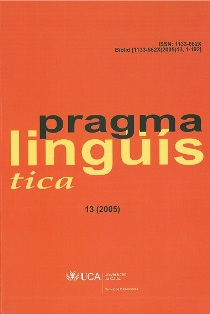Adquisición del rasgo [± PERFECTIVO] en español.

DOI
https://doi.org/10.25267/Pragmalinguistica.2005.i13.08Información
Resumen
Este estudio investiga la adquisición de la morfología verbal y de las propiedades semánticas del imperfecto e indefinido del español por parte de niños bilingües y por adultos de español como L2. El marco teórico que adoptaremos es el análisis generativista (de Miguel 1992; 1999; Giorgi y Pianesi 1997) según el cual el español difiere del inglés en la forma de codificar el Aspecto. Trece niños bilingües español/inglés y 14 niños de inglés/español junto con 9 adultos ingleses de nivel avanzado en español realizaron un test de nivel junto con una tarea de Reconocimiento de Morfología verbal y otra de Gramaticalidad de Decisión Lógica. Según los resultados, ningún participante confunde las formas verbales; aunque sí muestran ciertas dificultades a la hora de identificar las propiedades semánticas de ambos tiempos, las diferencias son entre los tres grupos significativas. Estos resultados reflejan la diferenciación paramétrica del español e inglés y la influencia cros-lingüística de una lengua sobre otra.
Descargas
Cómo citar
Licencia
Derechos de autor 2018 Pragmalingüística

Esta obra está bajo una licencia internacional Creative Commons Atribución-NoComercial-CompartirIgual 4.0.
Citas
ANDERSEN, ROGER. 1991. Developmental sequences: The emergence of aspect markingin second language acquisition. In: Thom Huebner y Charles A. Ferguson (Eds.), Crosscurrents in second language acquisition and linguistic theories, 305-324.Amsterdam: Benjamins.
ANDERSEN, ROGERY YASUHIRO SHIRAI. 1996. The primacy of Aspect in first and second language acquisition: the pidgin-creole connection. In: William C. Ritchie y Tej K. Bhatia (Eds.), Handbook of second language acquisition, 41-60. Hilldesviación están darale, NJ: Erlbaum.
ANTINUCCI, FRANCESCO Y RUTH MILLER 1976. How children can talk about what happened. Journal of Child Language 3, 169-189.
Autores, en prensa. Tiempo y Aspecto: estudio comparativo entre nativos y no-nativos de nivel avanzado de español. Hispanic Research Journal.
Autores. 2004. Adquisición de las propiedades morfosintácticas del español por parte de niños bilingües en etapas avanzadas. Estudios de Sociolingüística 5, 107-128.
BRONCKART, JEAN PAUL Y H. SINCLAIR 1973. Time, tense, and aspect. Cognition 2, 107-130.
CHOMSKY, NOAM. 1995. The Minimalist Program. MIT Press.
COMRIE, BERNARD. 1976. Aspect. Cambridge: Cambridge University Press.
CRAIN, STEPHEN Y ROSALIN THORNTON. 1998. Investigations in Universal Grammar. Cambridge, MA: MIT Press.
DE MIGUEL, ELENA. 1999. "El aspecto léxico". In: I. Bosque y V. Demonte (Eds.), Gramática descriptiva de la lengua española, Capítulo 46. Madrid: Espasa-Calpe.
DE MIGUEL, ELENA. 1992. El aspecto en la sintaxis del español: perfectividad e impersonalidad. Madrid: Ediciones de la Universidad Autónoma de Madrid.
DEPRAETERE, ILSE. 1995. On the necessity of distinguishing between (un) boundedness and (a)telicity. Linguistics and Philosophy 18, 1-19.
GARCÍA FERNÁNDEZ, LUIS. 1998. El aspecto grammatical en la conjugación. Ma-drid: Arcos/Libros.
GARCÍA FERNÁNDEZ, LUIS. 2004. El pretérito imperfecto. Madrid: Gredos.
GIORGI, ALEXANDRA Y FABIO PLANESI. 1997. Tense and Aspect: From Semantics to Morphosyntax. Oxford University Press.
HAWKINS, ROGER Y CECILIA CHAN. 1997. The partial availability of Universal Grammar in second language acquisition: the 'failed functional features hypothesis'. Second Language Research 13, 187-226.
JACOBSEN, TERESA. 1986. "¿Aspecto antes que tiempo? Una mirada a la adquisición temprana del español". In: Jürgen Meisel (Ed.), Adquisición del lenguaje-Aquisiçao a linguagem, 97-114. Frankfurt: Klaus-Dieter Vervuert Verlag.
LARDIERE, DONNA 1998. Dissociating syntax from morphology in a divergent end-state grammar. Second Language Research 14, 359-375.
LENNERBERG, ERIC. H. 1967. Biological foundations of language. New York: Wiley.
LEONETTI, MANUEL Y M. VICTORIA ESCANDELL VIDAL. 2002. On the Quotative Readings of Spanish Imperfecto. Cuadernos de Lingüística 10, 135-154.
MONTRUL, SILVINA. 2002. Competence and performance differences between monolinguals and 2nd generation bilinguals in the Tense/Aspect domain. In: James F. Lee, Kimberly L. Geeslin y J. Clancy Clements (Eds.), Structure, Meaning, and Acquisition in Spanish, 93-114. Cascadilla Press.
MONTRUL, SILVINA Y ROUMYANA SLABAKOVA 2002. The L2 acquisition of morphosyntactic and semantic properties of the aspectual tenses Preterite and Imperfect In: Ana T. Pérez-Léroux y Juana Liceras (Eds.), The acquisition of Spanish Morphosyntax: L1/L2 Connection, 115-151. Dordrecht: Kluwer.
PREVÓST, PHILIPPE Y LYDIA WHITE. 2000. Missing surface inflection or impairment in second language acquisition? Evidence from Tense and Agreement. Second Language Research 16, 103-134.
SALABERRY, RAFAEL. 2000. The development of past tense morphology in L2 Spanish. Philadelphia: Benjamins.
SANCHEZ, LILIANA (2004). Functional convergence in the tense, evidentiality and aspectual systems of Quechua Spanish bilinguals. Bilingualims: Language and Cognition 7, 147-162.
SILVA-CORVALÁN, CARMEN. 1991. Spanish language attrition in a contact situation with English. In: Herbert Seliger y Robert Vago (Eds.), First Language Attrition, 151-171. Cambridge: Cambridge University Press.
SILVA-CORVALÁN, CARMEN. 1994. Language Contact and Change: Spanish in Los Angeles. Oxford: Oxford University Press.
SMITH, CARLOTA 1991/1997. The Parameter of Aspect. Dordrecht: Kluwer.
VENDLER, ZENO. 1967. Linguistics in Philosophy. Ithaca, NY: Cornell University Press.
ZENTELLA, ANA CECILIA. 1997. Growing Up Bilingual. Puerto Rican Children in New York. Malden, MA: Blackwell.





